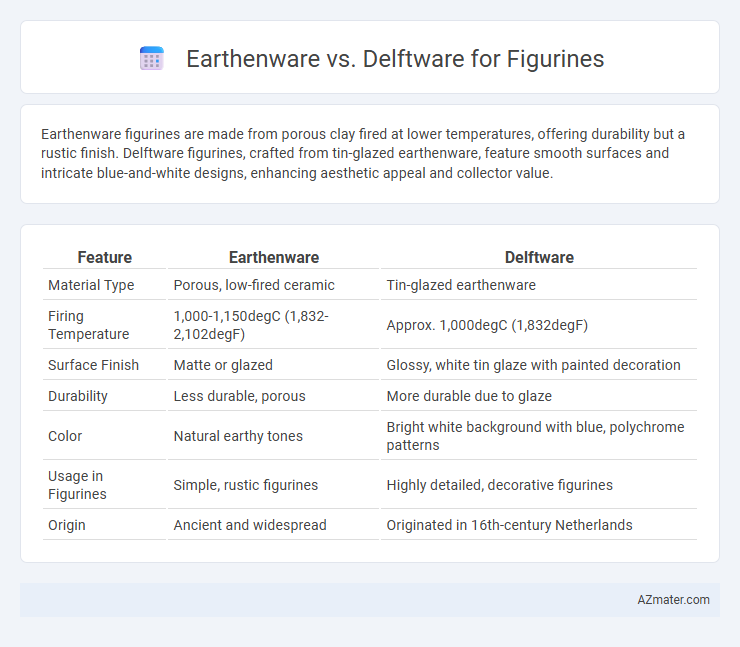Earthenware figurines are made from porous clay fired at lower temperatures, offering durability but a rustic finish. Delftware figurines, crafted from tin-glazed earthenware, feature smooth surfaces and intricate blue-and-white designs, enhancing aesthetic appeal and collector value.
Table of Comparison
| Feature | Earthenware | Delftware |
|---|---|---|
| Material Type | Porous, low-fired ceramic | Tin-glazed earthenware |
| Firing Temperature | 1,000-1,150degC (1,832-2,102degF) | Approx. 1,000degC (1,832degF) |
| Surface Finish | Matte or glazed | Glossy, white tin glaze with painted decoration |
| Durability | Less durable, porous | More durable due to glaze |
| Color | Natural earthy tones | Bright white background with blue, polychrome patterns |
| Usage in Figurines | Simple, rustic figurines | Highly detailed, decorative figurines |
| Origin | Ancient and widespread | Originated in 16th-century Netherlands |
Understanding Earthenware: Key Characteristics
Earthenware is a porous ceramic material fired at lower temperatures, typically between 1,000degC and 1,150degC, resulting in a dense, opaque body that is often glazed to enhance durability and aesthetic appeal. Its key characteristics include a coarser texture compared to porcelain and stoneware, a warm, earthy color palette, and relative softness that allows for intricate detailing in figurines but demands careful handling to avoid chipping. Delftware, a type of tin-glazed earthenware originating from the Netherlands, features a characteristic white glaze decorated with cobalt blue designs, highlighting its decorative appeal in contrast to more rustic traditional earthenware.
What Defines Delftware Pottery?
Delftware pottery is defined by its distinctive tin-glazed earthenware with a white, glossy surface that serves as a canvas for intricate blue hand-painted designs, often featuring floral patterns, landscapes, or historical scenes. Originating in the Dutch city of Delft during the 16th century, this ceramic style is characterized by its fine craftsmanship, vibrant cobalt oxide decoration, and a smooth, impermeable glaze that enhances durability. Compared to general earthenware, Delftware combines aesthetic elegance with functional resilience, making it a popular choice for collectible figurines and decorative art.
Historical Origins of Earthenware and Delftware
Earthenware, dating back to ancient civilizations such as Mesopotamia around 4,000 BCE, is a porous ceramic material fired at lower temperatures, traditionally used for everyday pottery and figurines. Delftware originated in 16th-century Netherlands, inspired by Chinese porcelain, featuring tin-glazed earthenware with characteristic blue and white designs, primarily produced in Delft. The historical roots of earthenware reflect functional utility, while Delftware signifies a cultural adaptation and artistic enhancement within European ceramic traditions.
Material Composition: Earthenware vs Delftware
Earthenware figurines are made from porous clay fired at lower temperatures, resulting in a softer and more absorbent material suitable for rustic decorative pieces. Delftware, a type of tin-glazed earthenware originating from the Netherlands, features a dense, white, and opaque surface created by applying a lead glaze with tin oxide, providing a smooth finish ideal for detailed blue-and-white designs. The tin glaze on Delftware not only enhances durability but also prevents absorption, making it more resistant to stains compared to standard earthenware.
Production Techniques: How Each Style is Made
Earthenware figurines are crafted using a porous clay fired at lower temperatures, typically between 1,000 and 1,150degC, which results in a more porous and less durable ceramic body; they are often hand-molded or slip-cast before being glazed and decorated. Delftware figurines originate from tin-glazed earthenware, employing a tin oxide glaze applied to the porous clay body, which is then fired at similar temperatures; the distinctive blue and white designs are hand-painted onto the unfired glaze before a second firing seals the artwork. The key technical distinction lies in Delftware's tin glaze process that provides a glossy, opaque white surface ideal for detailed pigment application, contrasting with the more absorbent and matte nature of traditional earthenware.
Visual Differences in Glaze and Color
Earthenware figurines typically exhibit a matte or slightly glossy glaze with earthy, warm tones ranging from terracotta reds to soft beige hues, highlighting natural clay textures. In contrast, Delftware figurines feature a distinctive bright white tin-glazed surface adorned with vivid cobalt blue patterns and details, creating a striking contrast and smooth, reflective finish. The color palette of Delftware is more limited but sharper, emphasizing intricate hand-painted designs, whereas earthenware embraces a broader, rustic color spectrum with a subtler glaze effect.
Durability and Longevity Comparison
Earthenware figurines, made from porous clay fired at lower temperatures, tend to be less durable and more prone to chipping or cracking over time compared to Delftware. Delftware, a type of tin-glazed pottery fired at higher temperatures, offers enhanced durability and resistance to moisture, significantly extending the longevity of figurines. Collectors seeking long-lasting, resilient figurines often prefer Delftware for its superior strength and preservation qualities.
Artistic Styles in Figurine Design
Earthenware figurines showcase rustic, hand-painted designs characterized by warm, earthy tones and textured surfaces, reflecting traditional folk art aesthetics. Delftware figurines feature intricate blue and white glazing with delicate floral and narrative motifs, emphasizing fine detail and a polished, glossy finish. The artistic styles of earthenware prioritize organic forms and regional authenticity, whereas Delftware highlights porcelain-inspired elegance and meticulous craftsmanship.
Collectibility and Market Value
Earthenware figurines are prized for their rustic charm and affordability, often appealing to collectors seeking traditional craftsmanship with a lower market entry. Delftware figurines, distinguished by their iconic blue and white glaze, command higher market values due to their historical significance and intricate hand-painted designs. Collectors typically value Delftware more for its heritage and artistry, resulting in greater demand and stronger investment potential compared to standard earthenware.
Choosing the Best Figurine: Factors to Consider
When choosing between earthenware and delftware figurines, consider factors such as material durability, glazing techniques, and historical value. Earthenware offers a more porous and heavier option with a rustic charm, while delftware features a tin-glaze finish that provides a smooth, glossy surface and iconic blue-and-white patterns. Prioritize your preference for aesthetic appeal, ease of maintenance, and the figurine's cultural significance to select the best piece for your collection.

Infographic: Earthenware vs Delftware for Figurine
 azmater.com
azmater.com